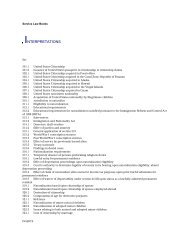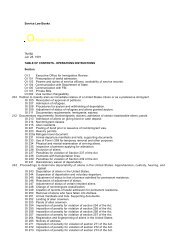Create successful ePaper yourself
Turn your PDF publications into a flip-book with our unique Google optimized e-Paper software.
<strong>Inspector's</strong> <strong>Field</strong> <strong>Manual</strong><br />
Chapter 23: Seaport Inspection.<br />
References:<br />
INA: Sections 212, 235, 251, 252, 253, 254, 255, 256, 257, 258, 273.<br />
Regulations: 8 CFR 212, 235, 251, 252, 253, 258; 22 CFR 41.41, 41.42.<br />
23.1 General.<br />
(a) Inspection of passengers and crewmembers in a seaport environment differs significantly from airport or<br />
land border inspection. Many of the procedures have been only slightly modified from inspectional procedures<br />
developed many years ago, before the advent of commercial airlines. Most vessels inspected nowadays are<br />
cargo vessels, with only crewmembers on board. Passenger vessels are predominantly cruise ships, with most<br />
passengers beginning and ending their trips in the United States. Cruise ship inspection, involving a large<br />
volume of U.S. citizen passengers and crewmembers who may have made several entries in just a few weeks, is<br />
handled either upon arrival or en route, using a relatively small inspection staff. Cargo vessels are inspected in<br />
port or "in-stream," based on arrangements made by the vessel's agent.<br />
A list of ports-of-entry for arrival of international vessels is included in 8 CFR 100.4(c)(2). Ports-of-entry for<br />
international arrival are designated by the Commissioner of Customs and approval for the inspection of aliens<br />
at such ports must be granted by the Commissioner of Immigration.<br />
(b) In-stream boardings. In-stream boardings can be more hazardous and time-consuming, and are typically<br />
used when a ship will be at anchor for a prolonged period prior to docking or will proceed to a docking facility<br />
which is distant from the major port area. Such boardings are generally arranged to accommodate the needs of<br />
the vessel's operator, at the convenience of the government. A boarding party, usually an inspector each from INS<br />
and Customs and the ship's agent, meet the ship at a prearranged anchorage, using a tug, launch, or helicopter, as<br />
arranged by the agent. The inspecting officer must exercise judgment in deciding whether the boarding<br />
conditions are safe or whether the inspection should be delayed until docking.<br />
(c) Dockside inspections. Dockside inspection of vessels is arranged by the shipping agent. Inspection must be<br />
complete before any other activities commence, such as cargo off loading, conducting business with ship<br />
chandlers, etc. Ordinarily, the INS and Customs inspectors are at the dock when the ship's gangway is lowered<br />
and are the first to board. Others waiting to do business should be directed to refrain from such activities until<br />
the inspection is substantially completed, to avoid interference with the clearance process. Ships are usually in<br />
port for a limited time, incurring substantial charges for stevedores and other related activities. It is critical that<br />
the Federal inspection procedures are promptly and efficiently handled to avoid needless delays and increases<br />
to these costs.<br />
(d) En route inspections. (1) General. Because of the large volume of passengers and crew on many cruise<br />
vessels and the rapid turnaround time required for off loading passengers from one cruise and loading for the<br />
next, cruise lines often request that INS conduct the immigration inspection while the ship is en route from the<br />
last foreign port back to the United States. This type of inspection, while both cost-effective and customer-service<br />
oriented, is subject to scrutiny by the media as well as internally, since the prolonged presence of the inspector on<br />
a cruise vessel can easily give the outward appearance of being improper acceptance of a gift by a government<br />
employee. Because of this risk, Service policy on the conduct of en route inspections has been strictly laid out<br />
and must be followed in every detail.<br />
(2) Carrier requests for en route inspectional services. All requests for en route inspection service<br />
must be submitted by the carrier or agent to the district director of the district where services are being<br />
requested (first port of arrival). Requests must be in writing; they must be prospective in nature; and they must<br />
specify the circumstances requiring an en route inspection. Under no circumstances may a request be initiated by<br />
a Service office. Each request must specify the detailed reasons why an en route inspection is being requested<br />
and contain sufficient details to enable the district director to determine if an en route inspection is the best and




